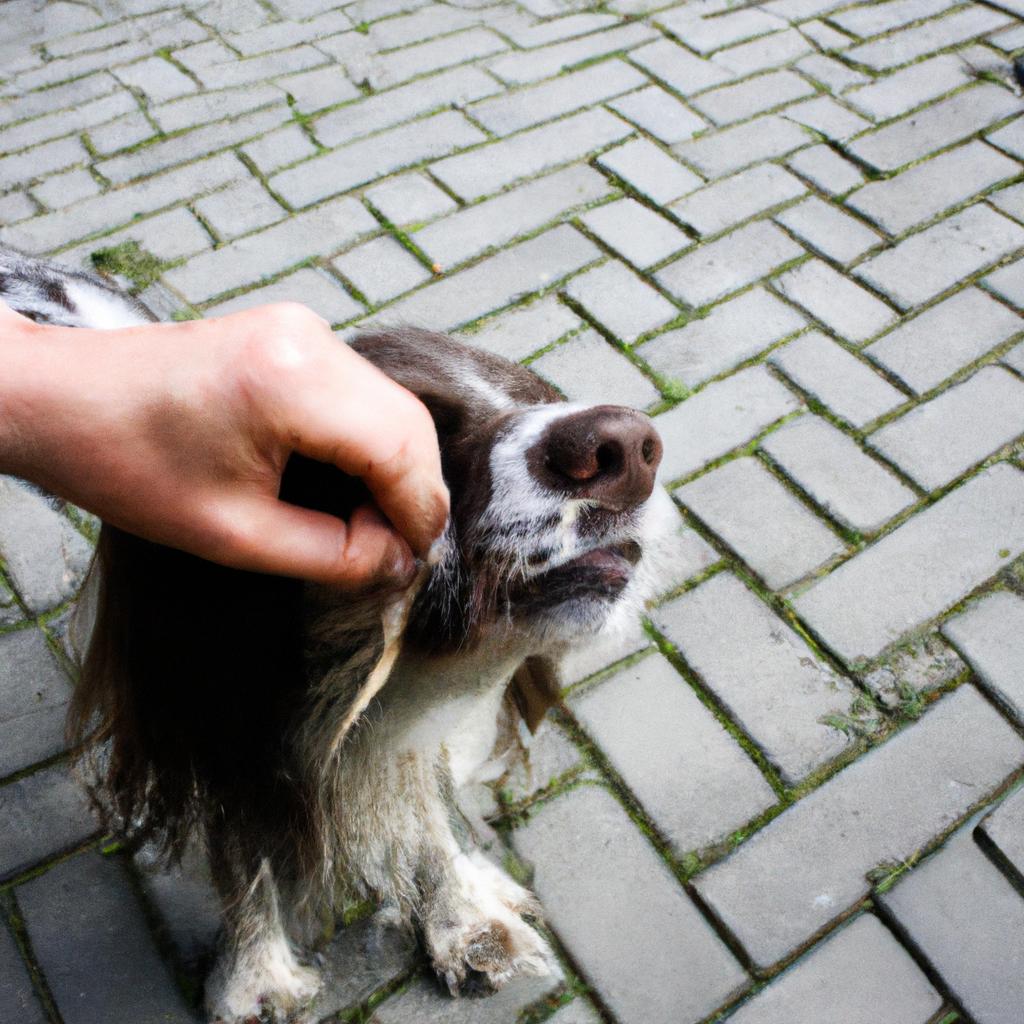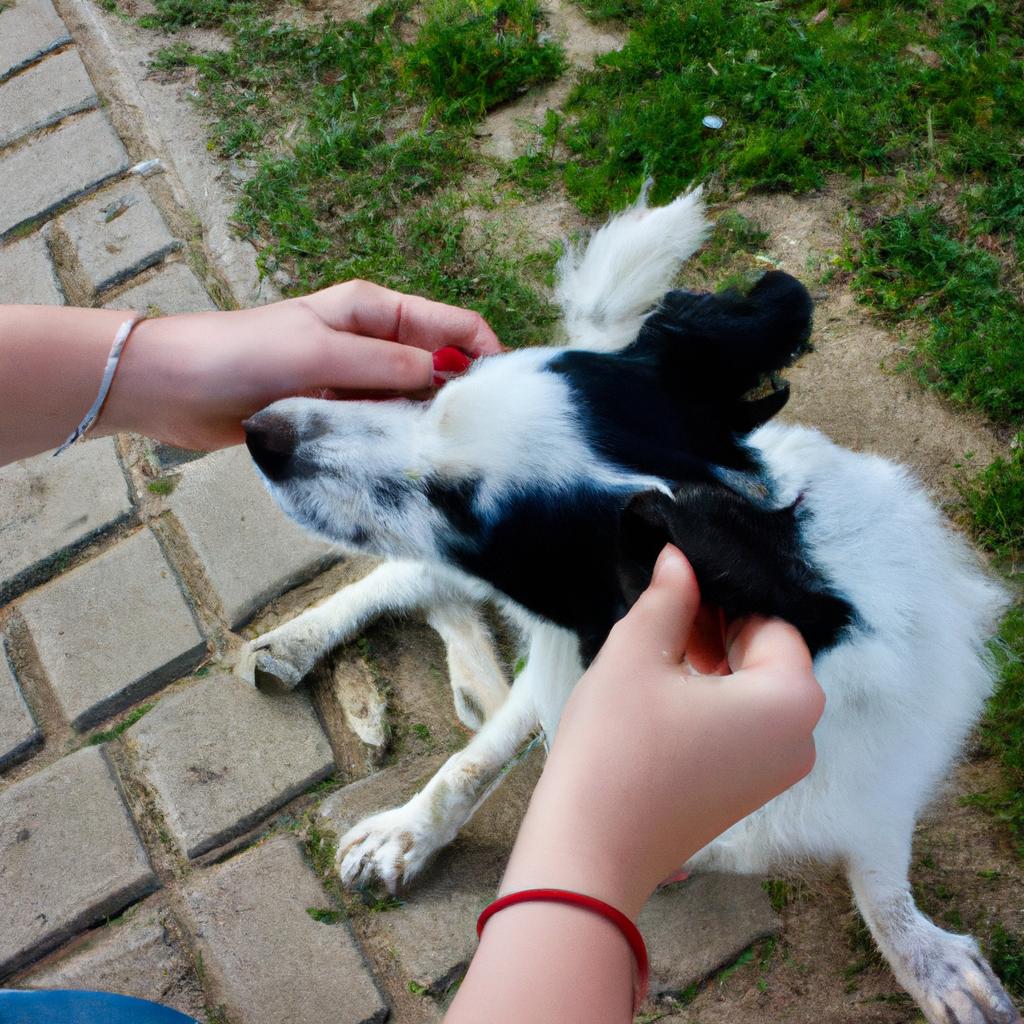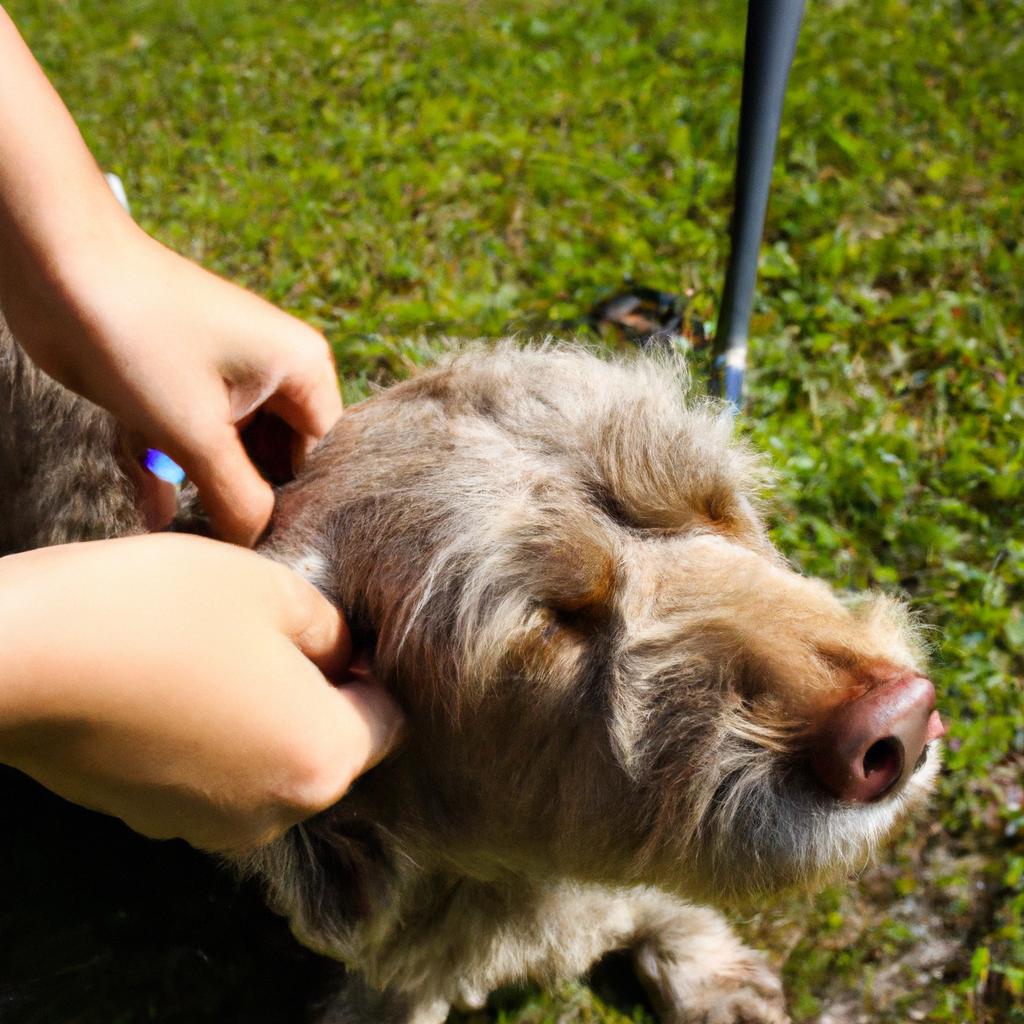Flea and Tick Treatment in Dog Grooming Salon: A Guide to Effective Ear Cleaning

Ear cleaning is an essential aspect of maintaining the overall health and well-being of dogs in a grooming salon. Proper ear hygiene helps prevent infections, discomfort, and other complications that can arise from flea and tick infestations. For instance, consider a hypothetical case where a dog named Max regularly visits a grooming salon for routine maintenance. Despite diligent care at home, Max develops an ear infection due to unaddressed fleas and ticks in his ears. This serves as a stark reminder of the importance of effective ear cleaning techniques within dog grooming salons.
In this guide, we will explore the significance of flea and tick treatment during the ear cleaning process in dog grooming salons. We will discuss various factors such as identifying common signs of infestation, understanding the underlying causes, and implementing appropriate preventive measures. Additionally, we will delve into the specific steps involved in executing an effective ear-cleaning procedure tailored to address flea and tick-related issues in dogs. By providing comprehensive insights into this topic, groomers can enhance their knowledge and skills to ensure optimal outcomes for both pets and their owners.
Understanding flea and tick infestations in dogs
Flea and tick infestations can cause significant discomfort and health issues for our beloved canine companions. These parasitic insects not only irritate the skin but also transmit diseases, such as Lyme disease and tapeworm infections. To effectively address these infestations, it is crucial to have a thorough understanding of their nature and characteristics.
To illustrate the impact of flea and tick infestations, consider the case of Max, a three-year-old Labrador Retriever. Max had been experiencing incessant scratching and biting at his ears, leading his owner to bring him to a dog grooming salon for treatment. Upon examination, the groomer discovered several fleas nestled deep within Max’s ear canal. This example highlights how even seemingly inconspicuous areas like the ears can become breeding grounds for these relentless parasites.
To gain further insight into flea and tick infestations, let us explore some key aspects:
-
Lifecycle: Fleas undergo four stages – egg, larva, pupa, and adult – while ticks progress through egg, larva/nymph (immature), and adult phases. Understanding this lifecycle helps identify appropriate treatment methods that target each stage effectively.
-
Transmission: Fleas often enter homes through outdoor environments or contact with other animals carrying them. Ticks primarily latch onto pets when they are outdoors in grassy or wooded areas where they wait on vegetation until an unsuspecting host passes by.
-
Health risks: Beyond causing itching and irritation, fleas and ticks pose significant health risks to dogs. They can transmit diseases such as Rocky Mountain spotted fever or ehrlichiosis (tick-borne illnesses) which may lead to severe complications if left untreated.
-
Prevention strategies: Regular grooming practices supplemented by preventive measures like using topical treatments or oral medications play a vital role in minimizing the risk of flea and tick infestations in dogs.
By understanding these fundamental aspects of flea and tick infestations, dog owners can take proactive measures to safeguard their pets’ health.
Common signs of flea and tick infestations in dogs
Understanding flea and tick infestations in dogs is crucial for effective flea and tick treatment in a dog grooming salon. Let’s dive deeper into the topic, exploring common signs of these infestations and how they can impact our canine companions.
Imagine a scenario where a pet owner brings their beloved dog to a grooming salon with concerns about excessive scratching and visible irritation on the dog’s skin. Upon examination, the groomer notices small, dark insects moving around the dog’s fur – an obvious sign of fleas. This case highlights the importance of being vigilant when it comes to identifying signs of flea and tick infestations in dogs.
To effectively address flea and tick infestations, there are several key considerations:
- Early detection: Regularly inspecting your dog’s coat and skin is essential for early detection of fleas or ticks. Look out for redness, swelling, hair loss, scabs, or small black/brown specks (flea dirt) resembling pepper flakes.
- Professional consultation: Seek advice from a veterinarian if you suspect your dog may have fleas or ticks. They can provide guidance on appropriate treatment options based on factors such as your dog’s health condition and lifestyle.
- Appropriate treatment: Use veterinarian-recommended products specifically designed to eliminate fleas and ticks while ensuring safety for your furry friend.
- Environmental control: Flea eggs, larvae, pupae, and adult stages all exist within an environment that includes not only your pet but also its surroundings like bedding, carpets, furniture etcetera. Therefore treating both the pet and its living space is important.
- Protecting our dogs from flea and tick infestation ensures their overall well-being.
- Prompt identification enables timely intervention against these parasites.
- Taking preventative measures helps avoid potential diseases caused by fleas or ticks.
- Providing comfort for our four-legged friends through effective pest management strategies.
Additionally, let us present a three-column table to demonstrate the lifecycle of fleas:
| Stage | Description | Duration |
|---|---|---|
| Egg | Laid on the host and falls off into the environment | 2 days |
| Larva | Develops in dark, humid areas like carpets or bedding | Up to 5 weeks |
| Pupa | Protects itself within a cocoon until conditions are favorable for emergence | Up to 20 days |
| Adult Flea | Emerges from the pupal stage to find a host | Several months |
Understanding these stages helps emphasize the importance of continuous treatment over an extended period, as well as thorough environmental control measures.
In transitioning to the next section about “Importance of regular ear cleaning for dogs,” it is crucial to address how flea and tick infestations can affect various parts of a dog’s body. One area prone to infestation is their ears. By exploring this topic further, we can ensure comprehensive care for our furry friends.
Importance of regular ear cleaning for dogs
Signs of flea and tick infestations in dogs can vary, but it is essential to be aware of these indicators to ensure early detection and prompt treatment. For instance, let’s consider a hypothetical scenario where an owner brings their dog into a grooming salon for regular maintenance. During the grooming process, the groomer notices excessive scratching, redness, and inflammation around the dog’s ears. These symptoms could suggest the presence of fleas or ticks.
To effectively address such issues, it is crucial to understand common signs that may indicate a flea or tick infestation:
- Excessive itching and scratching: Dogs affected by fleas or ticks often experience intense itchiness due to bites from these parasites.
- Redness and inflammation: Infected areas may become irritated, leading to redness and swelling.
- Hair loss: Flea or tick activity can cause hair loss in localized areas on your dog’s body.
- Presence of dark specks or “flea dirt”: Flea droppings resemble small black specks and are commonly found on a dog’s skin or coat.
Understanding these signs will allow you to take appropriate action promptly if you detect any potential infestation in your furry friend.
In addition to recognizing these indicators, maintaining proper ear hygiene is crucial for every pet owner. Regular cleaning helps prevent various ear-related problems such as infections, wax buildup, odor, and discomfort for your canine companion. By incorporating routine ear cleaning into your dog grooming regimen at a professional salon like ours, you can enhance their overall well-being.
Now let us delve deeper into the steps involved in effective ear cleaning within a dog grooming salon setting without further ado
Step-by-step guide to effective ear cleaning in a dog grooming salon
Section: The Impact of Neglected Ear Cleaning
Neglecting regular ear cleaning in dogs can lead to various health issues, such as infections and discomfort. To illustrate the importance of this grooming practice, consider a hypothetical case of Max, a golden retriever who has not received proper ear cleaning for an extended period. Max’s owner noticed his dog scratching excessively and shaking his head frequently. Upon examination at the grooming salon, it was discovered that Max had developed an ear infection due to accumulated dirt, wax, and moisture in his ears.
Effective ear cleaning involves several crucial steps that should be followed meticulously in a dog grooming salon. By adhering to these guidelines, groomers can ensure they are providing thorough care for their furry clients’ ears:
- Gentle Inspection: Prior to cleaning, it is essential to examine the dog’s ears carefully. Look out for signs of redness, swelling, excessive discharge, or foul odor.
- Proper Cleansing Techniques: Use veterinarian-approved cleansers specifically designed for canine ears. Apply a small amount onto a cotton ball or pad and gently wipe the visible parts of the inner ear without inserting anything into the ear canal.
- Preventing Moisture Build-Up: After cleansing, thoroughly dry the ear using a clean towel or gauze. Excess moisture left behind can create an ideal environment for bacteria and fungi to thrive.
- Regular Maintenance: Encourage pet owners to maintain consistent home care by recommending routine inspections and gentle cleaning between professional grooming sessions.
To emphasize the significance of timely and effective ear cleaning practices further, here is an emotional bullet point list highlighting potential consequences of neglect:
- Increased risk of painful ear infections
- Development of mites or parasites
- Chronic itching leading to self-inflicted injuries
- Gradual loss of hearing abilities over time
Now let us delve into recommended products for flea and tick prevention in dogs—an essential aspect of overall canine health and well-being.
Recommended products for flea and tick prevention in dogs
Imagine a scenario where a dog named Max, a regular visitor at our grooming salon, came in for his routine ear cleaning. As we carefully examined his ears, we noticed tiny insects crawling inside. Upon closer inspection, it became apparent that Max had been infested with fleas and ticks. This incident highlights the importance of effective flea and tick prevention measures within a dog grooming salon setting.
Effective Flea and Tick Prevention Measures:
To ensure a clean and pest-free environment for both dogs and groomers, here are some essential steps to follow:
-
Regular Inspection: Thoroughly examine each dog’s ears during the grooming process to detect any signs of flea or tick infestation early on. Look out for excessive scratching or shaking of the head as potential indicators.
-
Proper Cleaning Technique: Adopt an efficient ear cleaning method using veterinarian-approved products specifically formulated to eliminate fleas and ticks from dogs’ ears. Administer these treatments with caution while following manufacturer instructions meticulously.
-
Timely Communication: If you discover signs of infestation during the grooming session, inform the dog owner promptly so they can seek appropriate veterinary care for their pet. Suggest suitable treatment options recommended by professionals to tackle the issue effectively.
-
Maintaining Hygiene Protocols: Implement strict hygiene practices within your grooming salon, such as frequent sanitization of equipment, bedding, and other surfaces exposed to dogs regularly. Regularly wash towels used during ear cleaning sessions at high temperatures to kill any lingering pests.
Table: Common Products for Flea and Tick Prevention
| Product Name | Description | Active Ingredients |
|---|---|---|
| Spot-on Treatments | Applied topically between shoulder | Fipronil, Imidacloprid |
| blades | ||
| Oral Medications | Administered orally in the form of | Fluralaner, Afoxolaner |
| chewable tablets | ||
| Collars | Worn around the dog’s neck to repel | Deltamethrin, Flumethrin |
| fleas and ticks |
By implementing these effective flea and tick prevention measures within your grooming salon, you can provide a safe and comfortable experience for both dogs and groomers. The early detection and treatment of infestations will help maintain a hygienic environment while ensuring the well-being of our furry clients.
Section Transition: With proper preventative measures in place to protect dogs from fleas and ticks during ear cleaning sessions, let’s now delve into essential tips for maintaining a clean and pest-free grooming salon environment.
Tips for maintaining a clean and pest-free grooming salon environment
Imagine a scenario where a dog named Max visits your grooming salon with his owner, Sarah. As you prepare to clean Max’s ears, you notice signs of discomfort and excessive scratching around the ear area. This indicates a potential flea or tick infestation that requires immediate attention. In this section, we will explore the best practices for effective ear cleaning in dog grooming salons, ensuring proper prevention and treatment of fleas and ticks.
Signposts and Transitions:
To ensure thorough ear cleaning and prevent further complications due to infestations, follow these guidelines:
-
Use appropriate products: It is essential to choose reliable and safe products specifically designed for treating fleas and ticks in dogs’ ears. Look out for ingredients like pyrethrin or pyrethroid compounds as they are effective against parasites while being gentle on the pet’s skin. Some recommended products include Product A, Product B, and Product C.
-
Follow manufacturer instructions: Each product comes with specific instructions on application methods, duration of use, and dosage requirements. Adhering strictly to these instructions ensures optimal efficacy without causing any harm to the dog’s ears or health. Be sure to educate yourself about each product thoroughly before using it on any canine clients.
-
Regular inspection during grooming sessions: Incorporate regular inspection of dogs’ ears into your grooming routine. By doing so, you can identify early signs of irritation or infestation promptly. If you detect symptoms such as redness, discharge, foul odor, or an increased presence of wax buildup, take necessary steps accordingly.
Emotional Bullet Point List (Markdown format):
The following list highlights why effective ear cleaning is crucial for maintaining a healthy environment in your dog grooming salon:
- Prevents discomfort and pain caused by flea or tick infestations.
- Reduces the risk of secondary infections and complications.
- Enhances overall well-being and comfort for dogs in your care.
- Builds trust with pet owners, showcasing your commitment to their pets’ welfare.
Emotional Table (Markdown format):
| Potential Complications | Consequences | Importance |
|---|---|---|
| Secondary infections | Pain, discomfort | Immediate attention required |
| Hearing loss | Reduced quality of life | Preventable through regular cleaning |
| Allergic reactions | Severe itching, inflammation | Early identification crucial |
| Transmission to other animals | Widespread infestation | Maintaining salon reputation |
By following these best practices, you can ensure effective ear cleaning in your dog grooming salon. Regular inspection, proper product usage, and adherence to manufacturer instructions are essential steps towards preventing flea and tick infestations while promoting the health and well-being of dogs under your care. Remember that maintaining a pest-free environment contributes not only to the comfort of individual pets but also to the overall success and reputation of your grooming salon.




